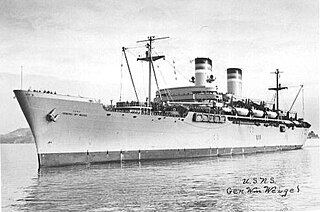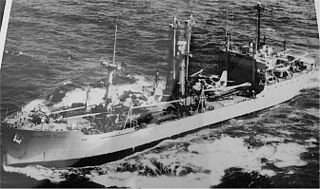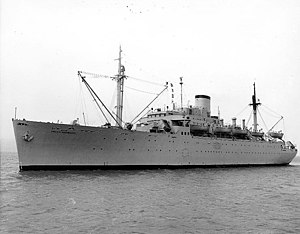
USS General D. E. Aultman (AP-156) was a General G. O. Squier-class transport ship for the U.S. Navy in World War II. The ship was crewed by the U.S. Coast Guard throughout the war. She was named in honor of U.S. Army general Dwight Edward Aultman. She was transferred to the U.S. Army as USAT General D. E. Aultman in 1946. On 1 March 1950 she was transferred to the Military Sea Transportation Service (MSTS) as USNS General D. E. Aultman (T-AP-156). She was later sold for commercial operation under the name SS Portland, before being scrapped some time after October 1986.

USS General A. W. Brewster (AP-155) was a General G. O. Squier-class transport ship for the U.S. Navy in World War II. The ship was crewed by the U.S. Coast Guard throughout the war. She was named in honor of U.S. Army general Andre Walker Brewster. She was transferred to the U.S. Army as USAT General A. W. Brewster in 1946. On 1 March 1950 she was transferred to the Military Sea Transportation Service (MSTS) as USNS General A. W. Brewster (T-AP-155). She was later sold for commercial operation under the name SS Philadelphia, before being scrapped some time after November 1987.

USS General R. L. Howze (AP-134) was a General G. O. Squier-class transport ship for the U.S. Navy in World War II. The ship was crewed by the U.S. Coast Guard throughout the war. She was named in honor of U.S. Army general Robert Lee Howze. She was transferred to the U.S. Army as USAT General R. L. Howze in 1946. On 1 March 1950 she was transferred to the Military Sea Transportation Service (MSTS) as USNS General R. L. Howze (T-AP-134). She was later sold for commercial operation under the name SS Austral Glen, before being scrapped in 1980.

USS General W. F. Hase (AP-146) was a General G. O. Squier-class transport ship for the US Navy in World War II. She was named in honor of US Army Major General William Frederick Hase. She was transferred to the US Army as USAT General W. F. Hase in 1946. On 1 March 1950 she was transferred to the Military Sea Transportation Service (MSTS) as USNS General W. F. Hase (T-AP-146). She was later sold for commercial operation in 1968, before being scrapped in 1985.

USS General E. T. Collins (AP-147) was a General G. O. Squier-class transport ship for the U.S. Navy in World War II. She was named in honor of U.S. Army general Edgar Thomas Collins. She was transferred to the U.S. Army as USAT General E. T. Collins in 1946. On 1 March 1950 she was transferred to the Military Sea Transportation Service (MSTS) as USNS General E. T. Collins (T-AP-147). She was later sold for commercial operation under the name SS New Orleans, before being eventually scrapped.

USS General M. M. Patrick (AP-150) was a General G. O. Squier-class transport ship built for the US Navy in World War II. She was named in honor of US Army general Mason Mathews Patrick, a graduate of the US Military Academy in 1886. Promoted to major general in 1918, during World War I, he was appointed Chief of the Army Air Service, the position he held until his retirement in 1927. After the Armistice, he represented the A.E.F. at the Paris Peace Conference.

USS General John Pope (AP-110) was a troop transport that served with the United States Navy in World War II. After the war she was transferred to the Army and redesignated USAT General John Pope. She later served in the Korean and Vietnam Wars as a civilian-crewed Military Sea Transportation Service vessel, as USNS General John Pope (T-AP-110).

USS General William Weigel (AP-119) was a troopship that served with the United States Navy in World War II. After the war, she was acquired by the US Army and became USAT General William Weigel. On the outbreak of the Korean War, she was transferred to the Military Sea Transportation Service (MSTS) and designated USNS General William Weigel (T-AP-119), a designation she retained for her later service in the Vietnam War.

USNS Henry Gibbins (T-AP-183) was a troop transport that served with the United States Military Sea Transportation Service (MSTS) during the 1950s. Prior to her MSTS service, she served as US Army transport USAT Henry Gibbins during World War II. She later served with the New York Maritime Academy as TS Empire State IV and with the Massachusetts Maritime Academy as USTS Bay State.

USNS Aiken Victory (T-AP-188) was a Victory ship-based troop transport that served with the United States Army Transport Service during both World War II and the Korean War. She was one of a class of 84 dedicated troop transports.

USNS Lt. Raymond O. Beaudoin (T-AP-189) was a troop transport that served with the United States Military Sea Transportation Service (MSTS) during the Korean War. Prior to her MSTS service, she served as a commercial vessel under the name SS Marshall Victory, and later with the US Army as USAT Lt. Raymond O. Beaudoin.

David C. Shanks was a troop transport that served with the US Army during World War II as USAT David C. Shanks, and during the Korean War with the US Navy's Military Sea Transportation Service as the USNS David C. Shanks (T-AP-180).

USNS Sgt. Sylvester Antolak (AP-192/T-AP-192) was a Boulder Victory-class cargo ship that served as a United States Army Transport, and in the United States Navy's Military Sea Transportation Service, in the post-World War II period.

USNS Coastal Crusader (AK-220/ORV-16/T-AGM-16/AGS-36) was an Alamosa-class cargo ship that was constructed for the US Navy during the closing period of World War II. She was later acquired by the US Army in 1946 and the US Air Force in 1957 before being reacquired by the USN in 1964 and as a missile range instrumentation ship.

USS Pembina (AK-200) – later known as USNS Pembina (T-AK-200) -- was an Alamosa-class cargo ship that was constructed for the U.S. Navy during the closing period of World War II. She supported the end-of-war Navy effort and was subsequently placed in service with the US Army under the Shipping Control Authority for the Japanese Merchant Marine with a Japanese crew in Yokosuka, Japan.
USNS Sgt. Morris E. Crain (T-AK-244) was a Boulder Victory-class cargo ship built at the end of World War II and served in the war prior to its demilitarization as a commercial cargo vessel. From post-war to 1950 she served the U.S. Army as a transport named USAT Morris E. Crain. In 1950 she was acquired by the U.S. Navy and assigned to the Military Sea Transportation Service. In 1975 she ended her career and was placed into reserve.

USNS Colonel William J. O’Brien (T-AK-246) was a US Maritime Administration (MARCOM) C1-M-AV1 type coastal cargo ship, originally planned as an Alamosa-class cargo ship. Constructed as Maiden's Eye for the MARCOM, completed in August 1945 and placed in operation by the War Shipping Administration (WSA). After the war Maiden's Eye was transferred to the US Army and renamed USAT Colonel William J. O’Brien who kept her in service until transferred to the US Navy in 1950 for operation as USNS Colonel William J. O’Brien (T-AK-246) by the Military Sea Transportation Service (MSTS) until 1973.
USNS Private John F. Thorson (T-AK-247) was a US Maritime Administration (MARCOM) C1-M-AV1 type coastal cargo ship, originally planned as an Alamosa-class cargo ship. Constructed as Becket Bend for MARCOM, completed in August 1945 and placed in operation by the War Shipping Administration. However, the war ended, and she was transferred to the US Army as USAT Private John F. Thorson who kept her in service until transferred to the US Navy in 1950. She was struck in 1960, ending her military career.
USNS Short Splice (T-AK-249) was a US Maritime Administration (MARCOM) C1-M-AV1type coastal cargo ship, originally planned as an Alamosa-class cargo ship. Constructed as Short Splice for MARCOM, completed in August 1945 and placed in operation by the War Shipping Administration during the closing period of World War II. However, the war ended, and she was transferred to the US Army as USAT Short Splice who kept her in service until transferred to the US Navy in 1950.

USNS Marine Adder (T-AP–193) was a troop ship for the United States Navy in the 1950s. She was built in 1945 for the United States Maritime Commission as SS Marine Adder, a Type C4-S-A3 troop ship, by the Kaiser Company during World War II. In 1950, the ship was transferred to the Military Sea Transport Service of the U.S. Navy as a United States Naval Ship staffed by a civilian crew. After ending her naval service in 1957, she entered the National Defense Reserve Fleet, but was sold for commercial use in 1967. She was used in part to carry supplies to support the Vietnam War efforts. During the summer of ‘72 while in Da Nang harbor, South Vietnam a limpet mine was attached to the hull by a swimmer. The mine blew a hole in the hull. In order to save the ship the Skipper ran it aground in Da Nang harbor. The USS Navy standby salvage ship USS Grasp with its crew of divers installed a box patch over the hole and pumped the water from the bilges, before moving the ship to a pier. US Army tanks hung from ship booms to heel the ship so that a metal patch could be welded in place to return the ship to duty. SS Transcolorado, she was chartered by the Military Sealift Command as a civilian cargo ship designated T-AK-2005.

















